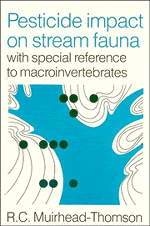Book contents
- Frontmatter
- Contents
- Preface and Acknowledgements
- PART I INTRODUCTION AND ORIGIN OF PESTICIDES IN RUNNING WATERS
- PART II THE ROLE OF LABORATORY AND EXPERIMENTAL METHODS IN EVALUATION
- PART III EVALUATION IN PEST CONTROL PROJECTS
- SIX Introduction to field sampling of aquatic macroinvertebrates in streams and rivers
- SEVEN Impact of insecticides used in control of the spruce budworm
- EIGHT Aquatic environmental effects of insecticides used in tsetse fly control
- NINE Effect on non-targets of larvicides applied to running waters for control of blackfly (Simulium) larvae
- TEN Impact of piscicides (and molluscicides)
- ELEVEN Herbicides and aquatic invertebrates
- Summary and assessment
- References
- Index
SEVEN - Impact of insecticides used in control of the spruce budworm
Published online by Cambridge University Press: 05 November 2011
- Frontmatter
- Contents
- Preface and Acknowledgements
- PART I INTRODUCTION AND ORIGIN OF PESTICIDES IN RUNNING WATERS
- PART II THE ROLE OF LABORATORY AND EXPERIMENTAL METHODS IN EVALUATION
- PART III EVALUATION IN PEST CONTROL PROJECTS
- SIX Introduction to field sampling of aquatic macroinvertebrates in streams and rivers
- SEVEN Impact of insecticides used in control of the spruce budworm
- EIGHT Aquatic environmental effects of insecticides used in tsetse fly control
- NINE Effect on non-targets of larvicides applied to running waters for control of blackfly (Simulium) larvae
- TEN Impact of piscicides (and molluscicides)
- ELEVEN Herbicides and aquatic invertebrates
- Summary and assessment
- References
- Index
Summary
THE SPRUCE BUDWORM IN CANADA AND THE US
Since the early 1950s the spruce budworm (Choristoneura fumiferana) has posed a serious threat in parts of eastern Canada, particularly New Brunswick, (Eidt, 1975, 1977; Symons, 1977a) and adjacent states of the US (Nash, Peterson & Chansler, 1971). In order to protect the valuable timber trees against defoliation, the method of control originally adopted was aerial spraying with DDT, which was practised from 1952 onwards. Since that time the intensity and extent of the infestation has increased. In New Brunswick for example, between 1952 and 1957 the sprayed area increased from 75 × 103 ha to 2.3 × 106 ha (8876 sq. miles). Many of the areas treated twice a year recorded a total application of 560 g/ha DDT per annum, and it was after such heavy treatment that Atlantic salmon, living in streams and rivers in the sprayed forest area, were found to be severely affected.
DDT began to be phased out in 1968, and by 19 70 was replaced completely by organophosphorus compounds, mainly fenitrothion. By 1976 the sprayed area in New Brunswick had increased to 4.0 × 106 ha (15000 sq. miles). By that year infestation had extended to other provinces, Quebec, Ontario and parts of Newfoundland and Nova Scotia up to a total area of 30 × 106 ha.
Fenitrothion continues to be the insecticide of choice, in Canada, and at the time of writing appears unlikely to be superseded by other insecticides (D. C. Eidt, personal communication).
- Type
- Chapter
- Information
- Pesticide Impact on Stream FaunaWith Special Reference to Macroinvertebrates, pp. 128 - 160Publisher: Cambridge University PressPrint publication year: 1987



